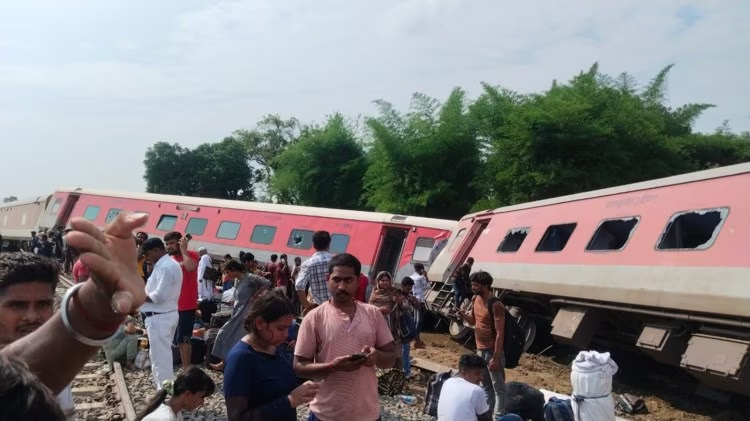In a tragic incident, the Chandigarh-Dibrugarh Express train derailed near Gonda district in Uttar Pradesh on Thursday, July 18, 2024, resulting in the loss of four lives and leaving over 2o passengers injured.
The accident occurred around 2:37 PM when the train, numbered 15904, was traveling from Chandigarh to Dibrugarh in Assam. According to reports to reports, at least eight coaches of the Passenger train derailed between the Motiganj and Jhilahi railway stations.
The loco pilot of the Chandigarh-Dibrugarh Express claimed that he heard a loud explosion right before the derailment, but the exact cause of the accident is still under investigation. Rescue operations were immediately launched, with the local administration and railway authorities rushing to the site to oversee the relief efforts.
Casualties and Injuries
The Uttar Pradesh Deputy Chief Minister, Brajesh Pathak, confirmed that four passengers had lost their lives in the accident, while at least 20 others sustained injuries. The injured were promptly transported to nearby medical facilities, including the Mankapur CHC and Gonda hospitals, for treatment.
The Ministry of Railways has announced an ex-gratia of Rs 10 lakh to the families of the deceased, 2.5 lakh for those with grievous injuries, and Rs 50,000 for minor injuries. Additionally, a high-level inquiry has been ordered, alongside the standard Commissioner of Railway Safety (CRS) investigation, to determine the root cause of the derailment.
Rescue and Relief Efforts
The rescue operations were swift, with the local administration and railway authorities mobilizing resources to the accident site. According to reports, five ambulances were initially deployed for the rescue efforts, and more were dispatched as the situation unfolded.
The Uttar Pradesh Relief Commissioner informed that one team from the National Disaster Response Force (NDRF) was sent from Lucknow and Balrampur to assist in the rescue operations. The State Disaster Response Force (SDRF) teams from three nearby districts were also called in to expedite the relief efforts.
The railway authorities set up help desks at the Chandigarh railway station to address the concerns of the passengers and their families. They also issued helpline numbers for the affected passengers to seek assistance and information regarding the incident.
Impact on Train Operations
The derailment of the Chandigarh-Dibrugarh Express caused significant disruptions to train operations in the region. The North Eastern Railway, under whose jurisdiction the accident occurred, announced that a special relief train would be dispatched from Gorakhpur to transport the remaining passengers to their respective destinations.
Additionally, the Railway Board issued helpline numbers for various stations along the Chandigarh-Dibrugarh route, including Furkating, Mariani, Simalguri, Tinsukia, and Dibrugarh, to assist the affected passengers.
Recurring Train Accidents in India
The Chandigarh-Dibrugarh Express derailment is the latest in a series of train accidents that have plagued the Indian Railway in recent years. In June 2024, the Kanchanjunga Express train accident claimed the lives of ten passengers near Rangapani station in the Katihar RailwayDivisionn.
Earlier, in October 2023, the Anand Vihar Terminal-Kamakhya Junction North East Express derailed near Raghunatpur Railway Station in Bihar, leading to four fatalities and injuring over 70 passengers. Another devastating collision between two passenger trains in Andhra Pradesh’s Vizianagaram district in October 2023 resulted in the deathof 14 passengers.
Theseincidentst have raised concerns about the safety and maintenance of the Indian Railways infrastructure, with the opposition parties criticizing thegovernment’ss handling of the situation. The Chandigarh-Dibrugarh Express derailment has once again brought the issue of railway safety to the forefront, with calls for immediate action to address the underlying problems.
Conclusion
The tragic derailment of the Chandigarh-Dibrugarh Express in Uttar Pradesh has left a trail of sorrow and devastation, claiming the lives of four passengers and injuring over 20othersr. The Swift response from the local authorities and the railway administration in launching rescue and relief operationsisn commendable, but the recurring nature of such incidentsunderscores the urgent need for a comprehensive review of the safety measures and infrastructure within the Indian Railways.
As the investigation into the root cause of this accident continues, the authorities must take concrete steps to enhance the safety and reliability of the country’s rail network, ensuring that such tragic incidents do not repeat in the future. The loss of precious lives is a somber reminder of the importance of prioritizing passenger safety and making the necessary investments to modernize and strengthen the Indian Railways.
